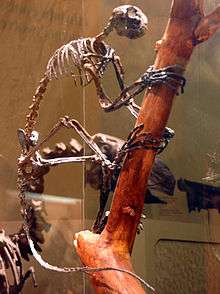Smilodectes
Smilodectes is a genus of adapiform primate that lived in North America during the middle Eocene.[1] It possesses a post-orbital bar and grasping thumbs and toes. Smilodectes has a small cranium size and the foramen magnum was located at the back of the skull, on the occipital bone.
| Smilodectes | |
|---|---|
 | |
| Smilodectes skeleton | |
| Scientific classification | |
| Kingdom: | Animalia |
| Phylum: | Chordata |
| Class: | Mammalia |
| Order: | Primates |
| Suborder: | Strepsirrhini |
| Family: | †Notharctidae |
| Subfamily: | †Notharctinae |
| Genus: | †Smilodectes Wortman, 1903 |
| Species | |
| |
Named species
There are three named species: Smilodectes gracilis, Smilodectes gingerichi and Smilodectes mcgrewi.[1]
Smilodectes gracilis
Smilodectes gracilis was an adapiformes primate from the early Eocene, some 55 million years ago. S. gracilis was found on the land mass of North America and based on its dental morphology, S. gracilis was a folivore.[2]
S. gracilis had a dental formula of 2.1.4.32.1.4.3 and had a relatively short snout, with rounded frontal bone as compared to other nothactines.[2] This species lacked symphyseal fusion[3] and this species of primate had comparatively reduced olfactory bulbs and a more expanded visual cortex.[2] This suggests that S. gracilis was a diurnal species.[2] S. gracilis had a cranial capacity of 9.5 cc.[3] It is thought that S. gracilis had an average body mass of around 2.1 kilograms.[2] Based upon its postcranial skeleton, S. gracilis was a vertical clinger and leaper.[3]
References
- Gebo 2002, p. 26.
- Fleagle, J. G. (1988). Primate Adaptation and Evolution. New York: Academic Press.
- Martin, R. D. (1990). Primate Origins and Evolution: A Phylogenetic Reconstruction. Princeton, New Jersey: Princeton University Press.
Literature cited
- Gebo, D.L. (2002). "Adapiformes: Phylogeny and adaptation". In Hartwig, W.C. (ed.). The Primate Fossil Record. Cambridge University Press. ISBN 978-0-521-08141-2. OCLC 47254191.CS1 maint: ref=harv (link)